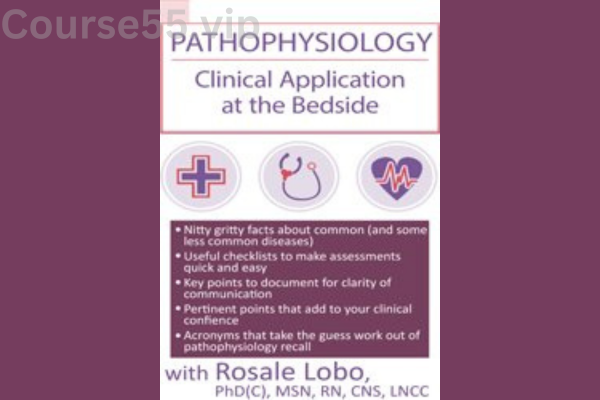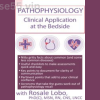Pathophysiology: Clinical Application at the Bedside By Rosale Lobo – PESI
$199.00 Original price was: $199.00.$23.10Current price is: $23.10.
Pathophysiology: Clinical Application at the Bedside by Rosale Lobo – PESI – Digital Download!

Pathophysiology: Clinical Application at the Bedside By Rosale Lobo – PESI
Overview

Pathophysiology: Clinical Application at the Bedside – A Deep Dive into Rosale Lobo’s Approach
Understanding pathophysiology is fundamental for healthcare professionals and nursing educators, as it forms the basis for effective patient care. Pathophysiology: Clinical Application at the Bedside by Rosale Lobo is a vital resource designed to bridge the gap between theoretical knowledge and real-world clinical applications. This comprehensive program aims to equip medical professionals with the skills needed to contextualize disease processes, thereby enhancing clinical reasoning and bedside assessments. As healthcare continues to evolve, having real-time, applicable knowledge is crucial, and this course provides a framework that allows practitioners to connect theoretical principles with patient-centered care.
A key focus of this course is integrating pathophysiological knowledge into nursing education and clinical settings. One of Lobo’s standout contributions is her emphasis on succinct overviews of various illnesses, enabling professionals to grasp the relationships between symptoms, diagnostics, and treatment options. By presenting clear and concise information, healthcare providers can develop a better understanding of complex disease processes, allowing them to identify health issues, interpret clinical data, and implement appropriate interventions.
Integrating Pathophysiology into Clinical Practice
In the rapidly evolving field of healthcare, linking pathophysiology to patient care is essential. Rosale Lobo introduces a variety of strategies to enhance the integration of pathophysiology into nursing education, ultimately benefiting both medical professionals and patient outcomes. One such strategy is a structured framework that guides healthcare providers through the intricacies of diseases commonly encountered in clinical environments.
The course highlights the importance of understanding key pathophysiological aspects of prevalent conditions such as acute kidney injury, neuromuscular weakness in ICU patients, and disturbances in cerebral circulation. By comprehending these essential principles, clinicians can make informed decisions at the bedside, connecting physiological dysfunctions to observable clinical symptoms.
To further improve clinical competence, the program underscores the significance of implementing effective assessment techniques. For example, understanding cerebral blood flow and autoregulation is critical for managing patients with neurological concerns. These techniques not only provide a solid knowledge base but also emphasize the translation of theoretical concepts into practical, real-world patient care.
Enhancing Nursing Education Through Pathophysiology
Nursing educators play a crucial role in shaping the future of healthcare, making the integration of pathophysiological concepts into their teaching essential. This course presents multiple methodologies to help educators effectively incorporate these principles into their curriculum. By offering concise reviews of pathophysiological mechanisms for different illnesses, nursing programs can cultivate a deeper understanding among students while making complex information more approachable.
One of the most effective teaching methods Lobo highlights is the use of case studies. These real-world examples encourage nursing students to think critically and apply theoretical knowledge to practical scenarios. For example, a discussion on renal failure might include a case study tracking the progression of acute kidney injury, prompting students to analyze its underlying pathophysiology and its impact on patient care.
Additionally, the course emphasizes the value of fostering discussions about how these concepts directly influence patient assessments and treatment decisions. By engaging in these conversations, students can better appreciate the interplay of symptoms, diagnostics, and therapeutic interventions, reinforcing the holistic approach necessary for high-quality patient care.
Key Clinical Assessment Techniques
A major component of Lobo’s program is the exploration of how critical assessment techniques tie into understanding pathophysiology at the bedside. For instance, evaluating neuromuscular weakness in ICU patients requires recognizing underlying causes such as metabolic disorders or electrolyte imbalances. Healthcare professionals must be equipped with the knowledge to detect these conditions early and take appropriate action.
Connecting Pathophysiology to Clinical Outcomes
As healthcare professionals conduct patient assessments, making connections between pathophysiological changes and observable symptoms is crucial. For example, disruptions in cerebral circulation can lead to severe complications if not managed promptly. By understanding the mechanisms behind cerebral blood flow disturbances, practitioners can tailor their assessments and interventions more effectively.
Additionally, bridging the gap between theoretical knowledge and clinical practice is vital. Strengthening this connection not only enhances the clinical reasoning skills of healthcare providers but also builds confidence in their decision-making abilities. Conducting thorough assessments enables professionals to detect early warning signs of complications, leading to timely and potentially life-saving interventions.
Strengthening Clinical Reasoning Skills
Lobo’s course prioritizes the development of critical thinking and clinical reasoning—both of which are indispensable in modern healthcare, where swift and informed decisions can greatly impact patient outcomes. By focusing on the relationship between pathophysiology and clinical practice, the course prepares medical professionals to approach patient care systematically and effectively.
To enhance clinical reasoning, Lobo emphasizes several core strategies, including:
-
Ongoing Education – Staying updated with the latest advancements in pathophysiology through continued learning in workshops and courses.
-
Collaborative Learning – Encouraging teamwork among healthcare providers to discuss and solve clinical cases that highlight pathophysiological principles.
-
Simulation-Based Training – Using simulation exercises in educational settings to provide hands-on experience with complex clinical situations, improving diagnostic and decision-making skills.
These approaches reinforce a strong foundation in pathophysiology, equipping professionals to manage complex cases effectively through simulations and interactive case discussions.
Conclusion
In summary, Pathophysiology: Clinical Application at the Bedside by Rosale Lobo is an essential resource for both nursing educators and healthcare practitioners. By emphasizing the critical connection between theoretical pathophysiology and its clinical applications, this program significantly enhances decision-making, critical thinking, and patient care strategies. Through structured approaches to incorporating pathophysiology into nursing education, along with advanced clinical assessment techniques and strengthened clinical reasoning skills, healthcare providers are better prepared to deliver exceptional patient care in diverse settings. Lobo’s work underscores the idea that a deep understanding of pathophysiology is not just beneficial—it is fundamental to achieving optimal patient outcomes.
Frequently Asked Questions:
Business Model Innovation: We operate a group buying strategy, allowing participants to share costs and access popular courses at reduced prices. This model benefits individuals with limited financial resources, despite concerns from content creators about distribution methods.
Legal Considerations: The legality of our operations involves complex issues. Although we don’t have explicit permission from course creators to resell their content, there are no specific resale restrictions stated at the time of purchase. This ambiguity creates an opportunity for us to provide affordable educational resources.
Quality Control: We ensure that all course materials purchased are identical to those offered directly by the creators. However, it’s important to understand that we are not official providers. As such, our offerings do not include:
– Live coaching calls or sessions with the course author.
– Access to exclusive author-controlled groups or portals.
– Membership in private forums.
– Direct email support from the author or their team.
We aim to reduce the cost barrier in education by offering these courses independently, without the premium services available through official channels. We appreciate your understanding of our unique approach.
Be the first to review “Pathophysiology: Clinical Application at the Bedside By Rosale Lobo – PESI” Cancel reply
You must be logged in to post a review.

 Healthy Hormone Done-For-You By Lorene Sauro
Healthy Hormone Done-For-You By Lorene Sauro  Ten Best-Ever Anxiety Treatment Techniques By Margaret Wehrenberg - PESI
Ten Best-Ever Anxiety Treatment Techniques By Margaret Wehrenberg - PESI  Intermediate To Advanced Breath-Control Course By Simon Borg-Olivier
Intermediate To Advanced Breath-Control Course By Simon Borg-Olivier 












Reviews
There are no reviews yet.